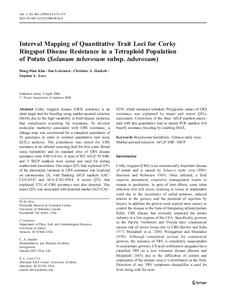| dc.contributor.author | Khu, D.M. |
| dc.contributor.author | Lorenzen, J.H. |
| dc.contributor.author | Hackett, C.A. |
| dc.contributor.author | Love, S.L. |
| dc.date.accessioned | 2019-12-04T11:20:50Z |
| dc.date.available | 2019-12-04T11:20:50Z |
| dc.date.issued | 2008 |
| dc.identifier.citation | Khu, D.M., Lorenzen, J., Hackett, C.A. & Love, S.L. (2008). Interval mapping of quantitative trait loci for corky ringspot disease resistance in a tetraploid population of potato (Solanum tuberosum subsp. tuberosum). American Journal of Potato Research, 85(2), 129-139. |
| dc.identifier.issn | 1099-209X |
| dc.identifier.uri | https://hdl.handle.net/20.500.12478/3534 |
| dc.description.abstract | Corky ringspot disease (CRS) resistance is an ideal target trait for breeding using marker-assisted selection (MAS) due to the high variability in field disease incidence that complicates screening for resistance. To develop molecular marker(s) associated with CRS resistance, a linkage map was constructed for a tetraploid population of 92 genotypes in order to conduct quantitative trait locus (QTL) analysis. The population was tested for CRS resistance in an infested screening field for four years. Broad sense heritability and its standard error of CRS disease resistance were 0.80 (±0.16). A total of 892 AFLP, 95 SSR, and FIVE SSCP markers were scored and used for testing marker-trait association. One major QTL that explained 43% of the phenotypic variation in CRS resistance was localized on chromosome IX, with flanking AFLP markers AAC-CGT-0347 and ACG-CTG-0588. A minor QTL that explained 12% of CRS resistance was also detected. This minor QTL was associated with distorted marker GGT-CAC-0259, which remained unlinked. Polygenetic nature of CRS resistance was explained by major and minor QTLs association. Conversion of the three AFLP markers associated with this quantitative trait to simple PCR markers will benefit resistance breeding by enabling MAS. |
| dc.description.abstract | La resistencia a la mancha de anillo corchoso (CRS) es un carácter ideal para el mejoramiento mediante la selección asistida por marcador (MAS), debido a la gran variabilidad de la incidencia de la enfermedad en el campo, la misma que complica el tamizado para resistencia. Para desarrollar marcadores moleculares asociados con resistencia a CRS, se construyó un mapa de ligamiento para una población tetraploide de 92 genotipos, con el fin de realizar un análisis de locus de un carácter cuantitativo (QTL). La población fue probada para resistencia a CRS tamizando por cuatro años en un campo infestado. La heredabilidad en sentido amplio de la resistencia a CRS, y su error estándar, fue de 0.80 (±16). Un total de 892 marcadores AFLP, 95 SSR y 5 SSCP fueron tomados en cuenta y usados para probar la asociación marcador–carácter. Un QTL mayor que explicó el 43% de variación fenotípica en resistencia al CRS fue localizado en el cromosoma IX, con marcadores AFLP flanqueantes, AAC-CGT-0347 y ACG-CTG-0588. Un QTL menor que explicó el 12% de resistencia al CRS fue detectado también. Este QTL menor fue asociado con el marcador distorsionado CGT-CAC-0259, el cual permaneció sin ligamiento. La naturaleza poligenética de la resistencia al CRS fue explicado por la asociación de los QTLs mayor y menor. La conversión de los tres marcadores AFLP asociados con este carácter cuantitativo en marcadores simples PCR, beneficiará el mejoramiento para resistencia haciendo posible la aplicación de MAS. |
| dc.language.iso | en |
| dc.language.iso | fr |
| dc.subject | Broad Sense Heritability |
| dc.subject | Tobacco Rattle Virus |
| dc.subject | Marker-Assisted Selection |
| dc.subject | Aflp |
| dc.subject | Ssr |
| dc.subject | Sscp |
| dc.title | Interval mapping of quantitative trait loci for Corky Ringspot Disease resistance in a Tetraploid population of potato (Solanum tuberosum subsp. tuberosum) |
| dc.type | Journal Article |
| dc.description.version | Peer Review |
| cg.contributor.affiliation | University of Nebraska |
| cg.contributor.affiliation | University of Idaho |
| cg.contributor.affiliation | Biomathmatics and Statistics Scotland |
| cg.contributor.affiliation | International Institute of Tropical Agriculture |
| cg.coverage.region | Acp |
| cg.coverage.region | North America |
| cg.coverage.country | United States |
| cg.isijournal | ISI Journal |
| cg.authorship.types | CGIAR and advanced research institute |
| cg.iitasubject | Disease Control |
| cg.iitasubject | Plant Diseases |
| cg.iitasubject | Plant Breeding |
| cg.accessibilitystatus | Limited Access |
| local.dspaceid | 95506 |
| cg.identifier.doi | https://doi.org/10.1007/s12230-008-9016-4 |

